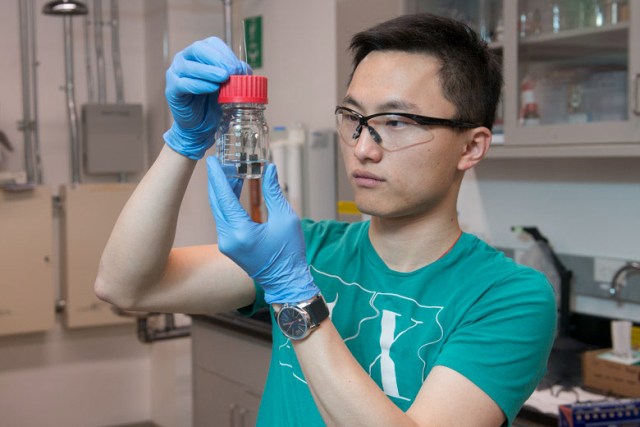Jun 25 2015
 Stanford graduate student Haotian Wang examines the novel water splitter that he and his colleagues developed to produce clean-burning hydrogen from water 24 hours a day, seven days a week
Stanford graduate student Haotian Wang examines the novel water splitter that he and his colleagues developed to produce clean-burning hydrogen from water 24 hours a day, seven days a week
Scientists at Stanford University have developed a cheap water splitter with a single catalyst to separate hydrogen and oxygen continuously. The device could be potentially used as a renewable source of clean-burning hydrogen fuel for industrial and transportation applications.
"We have developed a low-voltage, single-catalyst water splitter that continuously generates hydrogen and oxygen for more than 200 hours, an exciting world-record performance," said study co-author Yi Cui, an associate professor of materials science and engineering at Stanford and of photon science at the SLAC National Accelerator Laboratory.
Cui and his team created the low-cost catalyst using lithium-ion battery technology to initiate the water-splitting reaction.
"Our group has pioneered the idea of using lithium-ion batteries to search for catalysts. Our hope is that this technique will lead to the discovery of new catalysts for other reactions beyond water splitting," Cui said.
Although hydrogen has been considered as an efficient alternative to gasoline as it is emission-free, large quantities of commercial-grade hydrogen have been produced from natural gas, which causes global warming. Scientists have been working on the development of inexpensive and efficient method to separate pure hydrogen from water.
A typical water-splitting device includes two electrodes immersed in a water-based electrolyte. A catalytic reaction is triggered with the application of a low-voltage current to the electrodes, separating H2O molecules. As a result, hydrogen bubbles are released from one electrode while oxygen is released from the other.
Stanford water splitter produces clean hydrogen 24/7
Each electrode consists of a different catalyst, mostly rare, expensive metals like iridium and platinum. However, in 2014, Stanford chemist Hongjie Dai created a water splitter using inexpensive nickel and iron that operates on a conventional 1.5V battery. Cui and the team enhanced the technology further in this new study.
Our water splitter is unique because we only use one catalyst, nickel-iron oxide, for both electrodes. This bi-functional catalyst can split water continuously for more than a week with a steady input of just 1.5 volts of electricity. That's an unprecedented water-splitting efficiency of 82 percent at room temperature.
Haotian Wang
Lead Author of the Study
In order to maintain stability and remain active, the hydrogen and oxygen catalysts used in standard water splitters need different electrolytes with different pH. "For practical water splitting, an expensive barrier is needed to separate the two electrolytes, adding to the cost of the device. But our single-catalyst water splitter operates efficiently in one electrolyte with a uniform pH," Wang said.
The research team identified the nickel-iron oxide as an inexpensive and easy-to-produce alternative. It also has higher stability when compared to some of the precious metal-based commercial catalysts.
"We built a conventional water splitter with two benchmark catalysts, one platinum and one iridium. At first the device only needed 1.56 volts of electricity to split water, but within 30 hours we had to increase the voltage nearly 40 percent. That's a significant loss of efficiency," Wang said.
The scientists made use of a battery research technique called lithium-induced electrochemical tuning to check if the catalytic material can be used for both electrodes. This technique is adopted to chemically break the metal oxide catalyst into smaller portion using lithium ions.
Breaking down metal oxide into tiny particles increases its surface area and exposes lots of ultra-small, interconnected grain boundaries that become active sites for the water-splitting catalytic reaction.
This process creates tiny particles that are strongly connected, so the catalyst has very good electrical conductivity and stability.
Yi Cui
Associate Professor of Materials Science and Engineering
Stanford University
Wang tested the catalytic potential of various metal oxides through electrochemical tuning.
"Haotian eventually discovered that nickel-iron oxide is a world-record performing material that can catalyze both the hydrogen and the oxygen reaction. No other catalyst can do this with such great performance," Cui said.
He added that the use of single catalyst made of iron and nickel has significant cost benefits.
"Not only are the materials cheaper, but having a single catalyst also reduces two sets of capital investment to one. We believe that electrochemical tuning can be used to find new catalysts for other chemical fuels beyond hydrogen. The technique has been used in battery research for many years, but it's a new approach for catalysis. The marriage of these two fields is very powerful," Cui said.
The co-authors of the study include postdoctoral scholar Hyun-Wook Lee, visiting student Zhiyi Lu and graduate students Yong Deng, Po-Chun Hsu, Yayuan Liu and Dingchang Lin from Standford University.
The study was supported by the Stanford Interdisciplinary Graduate Fellowship program and the Global Climate and Energy Project at Stanford.
The study results have been reported in the June 23 edition of the Nature Communications journal.